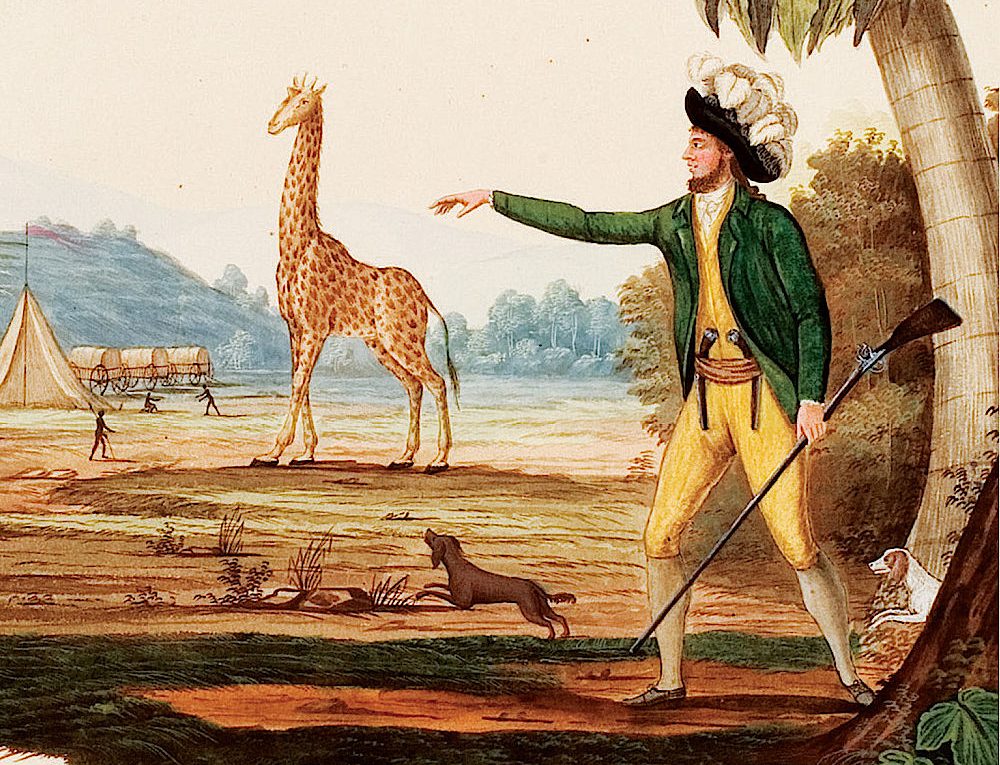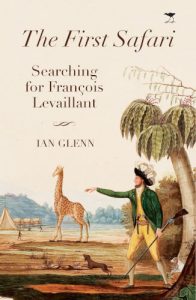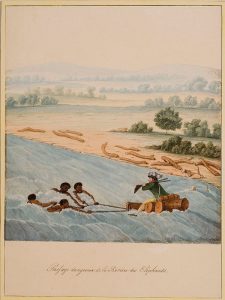One of the first literary figures in France with a double identity, a cultural hybridity – An excerpt from The First Safari
More about the book!

Read an excerpt from The First Safari: Searching for François Levaillant by Ian Glenn, out now from Jacana Media!
 The First Safari tells how, for a quarter of a century, Ian Glenn searched for Francois Levaillant’s notebooks and the fate of his collection and tried to solve puzzles and mysteries of Levaillant’s life and times.
The First Safari tells how, for a quarter of a century, Ian Glenn searched for Francois Levaillant’s notebooks and the fate of his collection and tried to solve puzzles and mysteries of Levaillant’s life and times.
Levaillant was the first and greatest South African birder, noted ornithologist, explorer, naturalist, zoological collector and anthropologist of the Cape. He collected thousands of specimens of birds and subsequently published the six-volume Histoire Naturelle des Oiseaux d’Afrique between 1799 and 1808. His contribution to ornithology in Africa was immeasurable, and some of his specimens still exist in museums in Europe.
Through his travels, he also shaped a range of media genres: the hunting narrative; the safari; the anthropological field record; the illustrated and mapped first-person account of travel we associate with National Geographic stories; the colonial adventure story with a well-armed hero; the erotic exotic; the investigative report on colonial brutality.
This book is intended for would-be researchers, for people wondering why writers as various as Nicolas Chamfort, Karel Schoeman, JM Coetzee and Michel Leiris admired Levaillant, for teachers looking for a new start for South African literature and for people interested in the bush or birding who want to know why Levaillant was our greatest naturalist.
The famous King’s Map that Levaillant inspired for King Louis XVI is also included in the book.
About the author
Ian Glenn has edited and co-translated an English translation of Levaillant’s Voyage into the Interior of Africa for the Van Riebeeck Society and co-authored the Brenthurst Press edition of François Levaillant and the Birds of Africa. He has written or co-authored many scholarly articles on Levaillant and curated the King’s Map exhibition at the Iziko Museum in 2012–2013.
Glenn studied at the University of KwaZulu-Natal, the University of York and the University of Pennsylvania, from which he graduated. He taught in and was Head of the Department of English at the University of Cape Town (UCT) and then helped found a new Centre for Film and Media Studies of which he was Director and First Professor of Media Studies. He is Emeritus Professor of Media Studies at UCT and a research associate at the University of the Free State. His current research interests include rhino poaching and the history of wildlife.
Read an excerpt:
Chapter I
Suriname and the making of the collector

Early life
Our hero was born François Vaillant, in Paramaribo, then part of Suriname or Dutch Guiana, to French parents on 6 August 1753. His father, Nicolas-François Vaillant, and mother, Catherine-Joséphine François, had eloped there because his mother’s father accused Nicolas of kidnapping his daughter and they had to leave France. The father came from a well-off bourgeois family from Metz in northern France, where many members had worked in legal professions. He had himself trained in law and acted as a king’s counsellor in France. In Guiana, he started a business, trading in natural history specimens, and acted as honorary French consul.
Levaillant described his childhood in Suriname and how it helped shape his later career in the introduction to Travels into the Interior. He grew up surrounded by an equatorial wilderness where he followed his parents on collecting expeditions and became obsessed by birds. He learned to hunt them with blowpipe and Indian bow and arrow and felt that ‘this taste was turning into a passion, a powerful passion that even troubled my hours of sleep and that the years have only made stronger’.
But he also attributed his desire for adventure and apparent indifference to social norms, to his upbringing. When he returned with his parents to France in 1763, and ‘neared the frozen climes of the north, a profound sadness attacked my soul and dissipated the glamour of the future’. How did this childhood in a Dutch colonial slaveholding culture help him in the Cape? Firstly, speaking and understanding Dutch enabled him to communicate with local farmers and the Khoikhoi (or Hottentots) working for him. It may also have been that growing up in a colony under Dutch commercial influence led his family to having connections that were to prove invaluable when it came to getting permission from the Dutch East India Company to travel to the Cape.
What were the costs and benefits of growing up ‘creole’—French but foreign, of the foreign house (‘creole’ stems from the Portuguese ‘corral’—South African ‘kraal’)? When I started working on the reception of Levaillant’s travel writings, an early and important find was the publisher’s publicity notice, or ‘prière d’insérer’, in the Journal Encyclopédique. It stressed the importance of Levaillant’s glamorous status as outsider. The publishers treated Levaillant as somebody who was an outsider to France and the Cape, able to comment with disinterested detachment.
Levaillant was thus able to play a kind of cultural chameleon role—was he French, Dutch, none of the above? His uprooted childhood gave him, he says, a kind of coldness, perhaps born of uncertainty and a complex double identity. He made fun of the French unwillingness to travel, comparing it to a mussel’s attachment to its rock,but he himself was torn. He longs for France at several points in his travel writing but in France he longs to be back in the African bush round the campfire. In his later life, he planned to return to Africa—either for a further expedition, or for good.
Levaillant’s Dutch connections may, as we see later, have helped him get to the Cape and to travel there, but his upbringing in Suriname may have given him a status with Dutch farmers in the interior that non-Dutch speaking foreigners like the Swedish botanist Anders Sparrman, official figures like Colonel Robert Gordon or later English officials like John Barrow simply did not have. Levaillant is the only one of the earlier commentators to predict an uprising and rebellion against the Company from the settlers—something which took place in Swellendam with a short-lived republic proclaimed in 1795. And his sense of the frontier farmers’ willingness to leave Company control for a new destiny foreshadows the Great Trek of the 1830s in ways the others do not foresee.
In France, while the Swiss-born Jean-Jacques Rousseau was one model of the uprooted intellectual influencing French culture, Levaillant may be the first having to negotiate a move from colonial periphery to metropolitan France. There is some evidence that his family was close to other French families with colonial ties, particularly with Haiti and India—for example, his daughter’s first husband came from a family with land holdings in Pondicherry.
Levaillant became one of the first literary and cultural figures in France (among later figures we can cite writers such as Albert Camus and JMG Le Clézio—and, of course, a host of African and Caribbean figures) with a double identity, a cultural hybridity, as part of the painful benefit of not being born into settled metropolitan French society. For all of them, negotiating the complex heritage of a colonial history becomes part of their burden, though Levaillant was one of the few who had to negotiate between different European languages.
Early life in France
In his own account of what he did after he got back to France, Levaillant talks primarily of hunting for two years in Germany and seven years in Alsace and Lorraine and learning methods of preserving bird specimens from an ornithologist and apothecary, Jean-Baptiste Bécoeur, who lived in Metz. Bécoeur had invented an arsenic-based soap compound which enabled him to improve the longevity of stuffed specimens. Bécoeur was involved in public disputes about the best way to preserve specimens but died before he could sell his formula, leaving Levaillant in possession of this valuable technique.
This soap was a great improvement on sulphur-based treatments, which had to be repeated regularly and which in time damaged the specimens. The certainty that one’s specimens could be preserved in good condition made a big difference to the practice of collecting and gave him confidence that the colours of specimens remained accurate, unlike the sulphur-treated specimens in use before. It also made taxidermy a far more valuable and important part of collecting. Having this technological advantage over other bird collectors must have given Levaillant confidence and also made investing in building up a collection of specimens worthwhile.
Reports at the time said that Levaillant was the best taxidermist of his age, able to treat a small bird in two minutes. In his own account of how he passed his days, he talks of spending the evening preparing specimens and writing up his journal. Given the many hazards he faced and the difficulties of dealing with a mass of unknown specimens, it is a tribute to his methodical and systematic classification that he managed to get so many correct. He talks of using different-coloured cotton thread to link labels to the specimens, and he must have had some system that enabled him to keep order in the confusion. Presumably he also had some of the arsenic soap available to help him preserve specimens during the heat of African summers.
Categories Non-fiction South Africa
Tags Book excerpts Book extracts Ian Glenn Jacana Media The First Safari
